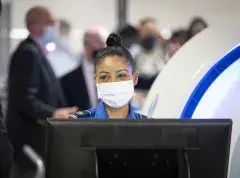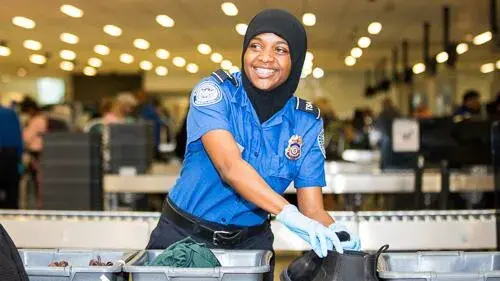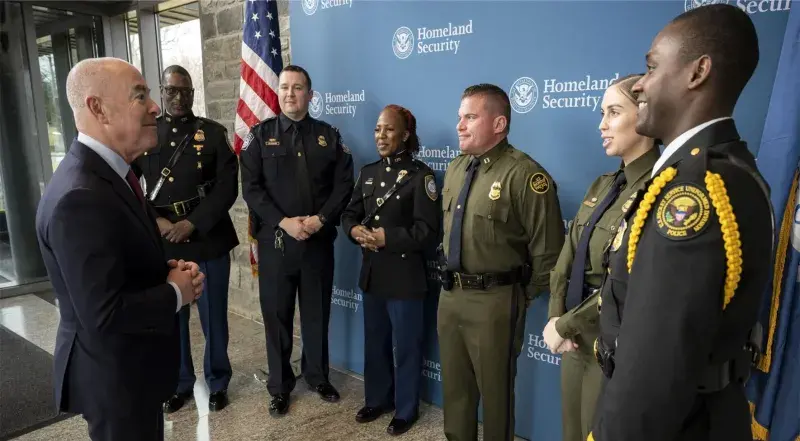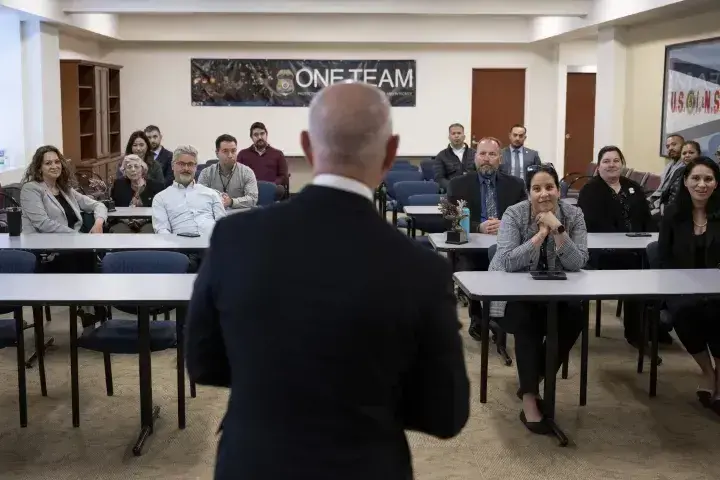
Letter from the Director
Dear Readers,
I'm thrilled to share the 2023 DHS Customer Experience Annual Report. It's a testament to our dedication to enhancing how we serve you.
Last year, we achieved significant milestones. We established a permanent Customer Experience (CX) Office and recruited over 70 experts. Our shift towards digital processes and simplified forms saved the public over 21 million hours.
We've made substantial progress in disaster assistance, immigration services, touchless travel, and gathering feedback to improve your experiences.
But our mission continues. In 2024, our focus remains unwavering. We aim to further reduce paperwork, enhance digital access, gather comprehensive experience data, and bring in more CX talent.
Take a look at the report for a taste of our remarkable progress over the last year. We're proud of our strides, but we're committed to an enduring journey of improvement. Our goal is to consistently provide dependable, trustworthy services for the public.
Warm regards,
The State of Customer Experience at DHS in 2023
Turning Touchpoints into “Trust Points”

We envision a people-focused Department of Homeland Security (DHS) that delivers trustworthy, fair, secure, and easy-to-access services.
Since 2021, DHS as a Department has made public-facing commitments to meet people where they are and deliver services that improve the lives of the public, or customers, we serve.
President Biden's Executive Order 14058, “Transforming Federal Customer Experience and Service Delivery to Rebuild Trust in Government,” directed agencies to focus on measuring and improving delivery and results for the people we serve. DHS has worked to embed CX practices across the Department to demonstrate and increase our accountability to the public.

“Customer experience” is the sum total of all of the touchpoints someone has with a service. Many touchpoints the public has with government services are time-consuming, confusing, and frustrating. When members of the public are confused or frustrated by a government service, it usually means that the government is doing a poor job of understanding their needs. And with over a billion interactions each year, the Department of Homeland Security (DHS) is dedicated to transforming our most impactful services to meet these needs.
Better customer experience means touchpoints we have with the public are more secure, equitable, efficient, effective, and accessible for everyone. Improvements to customers’ experiences help build trust in public services and empower DHS personnel to achieve our vital homeland security missions.
In 2023, DHS Formalized its Long-term Commitment to Improving Customer Experience and Service Delivery

Improving customer experience and service delivery has been a high priority for the Department for many years. One of Secretary Alejandro Mayorkas’s official, top priorities for 2023 was to “Innovate and transform our delivery of services to advance mission execution, improve the customer experience, and increase access to services.” In addition, DHS Chief Information Officer (CIO) Eric Hysen made improving service delivery through customer experience practices a pillar of the DHS Information Technology Strategic Plan 2024-2028.
In December of 2022, the Homeland Security Advisory Council (HSAC) recommended that DHS formalize and institutionalize its customer experience functions and provide transparency and accountability to the public. This recommendation led to DHS issuing Policy Statement 076-02, “Designing and Delivering Improved Customer Experience for the Public”, which created the Customer Experience Directorate (CXD) in the Office of the Chief Information Officer (OCIO) and directed DHS’ Operational Components Customs and Border Protection (CBP), Cybersecurity and Infrastructure Security Agency (CISA), Federal Emergency Management Agency (FEMA), Immigration and Customs Enforcement, (ICE) Transportation Security Administration (TSA), U.S. Coast Guard, United States Citizenship and Immigration Services (USCIS), and U.S. Secret Service) to formalize their customer experience functions by the end of FY 2024.
To support this growth and build customer experience capacity, CXD has grown to 36 staff with expertise in service design and delivery, user research, plain language, accessibility, product management, and more. Across DHS, programs hired 76 CX professionals in 2023. CX training and events also grew our workforce's skills and abilities, including monthly training on crucial skills like usability testing, and events like Accessibility Day, and CX Community Week. These events, and more, brought new skills and ideas to hundreds of DHS staff from attorneys to program managers to IT staff.
DHS Has Made Significant Progress in Modernizing Services and Improving Customers’ Experiences

Building a Program for Culture Change and Capacity Building
DHS has programmatic oversight of the public-facing CX commitments made by our partners in Customs and Border Protection (CBP), Federal Emergency Management Agency (FEMA), Transportation Security Administration (TSA), and U.S. Citizenship and Immigration Services (USCIS). CXD also established several new programs focused on culture change, capacity building, and cross-Department collaboration on services. Among our major accomplishments in this intense program-building year, we:
- Designed and delivered Artificial Intelligence (AI) training to the DHS Workforce. CXD provided instructional design, plain language, and usability support to roll out training to over 2000 (and still growing) members of the DHS workforce. AI training means more employees have access to additional tools to deliver better services.
- Hired 23 designers, product managers, and other experts into the DHS CX Directorate and supported the hire of more than 50 additional CX professionals across the Department.
- Hosted the 4th Annual Accessibility Day. This event raises awareness and provides education on making and delivering more accessible services. Accessibility Day, attended by over 600 participants, included presentations and panel discussions by internal and external subject matter experts.
- Highlighted CX excellence throughout DHS at the first Department-wide CX Demo Day, where we elevated awareness of Component accomplishments. Special guests Chief Information Officer Eric Hysen and DHS Deputy Secretary John Tien gave inspiring remarks that sparked enthusiasm across the CX community.
- Delivered a spectacular DHS CX Community Week, made up of more than 20 hours of riveting presentations and conversations. 400 attendees – including 20 with fresh recognition through a new CX awards program – came away energized and better prepared to commit themselves to further improving their customers’ experiences over the coming year.
- Developed an internal Accessibility Help Desk dashboard to track customer support activity and the quality of support provided to DHS personnel who need reasonable accommodation and assistive technology.
- Established a new accessible plain language program to coordinate and collaborate on efforts across the Department to communicate with the public and one another in plain language.
- Created the CX Metrics Dashboard to provide greater accountability and transparency for the public on DHS’ progress on improving customer experiences.
- Redesigned 18 training courses to educate individuals on developing, authoring and testing information communication technology (ICT) for accessibility, and certified 1,590 people across government and industry as DHS Trusted Testers.

Simplifying Services to Save Time
A major 2023 achievement was reducing public burden by over 21 million hours. DHS simplified forms, enabled online submissions, and sped up processing. Some examples:
- Transportation Security Administration (TSA) automated credential renewals for transportation workers. Less paperwork means workers can focus more on operations.
- Federal Emergency Management Agency (FEMA) upgraded an emergency reporting system used by fire departments. Cutting unneeded manual entry saves nearly 3 million collective hours yearly.
- U.S. Customs and Border Protection (CBP) transitioned ocean shipping data to digital formats. This shaved cargo clearance time from hours to minutes.
- U.S. Immigration and Customs Enforcement (ICE) streamlined student/exchange visitor applications by reusing data. Applicants now finish in 5 minutes versus much longer.

Focusing on Customers Most in Need
Over 2023, DHS transformed service design and delivery through our talented workforce and by implementing new technologies. This Department has improved experiences for the public and reduced administrative burden in many ways, including:
- Making services more accessible for customers: Most people applying for immigration benefits with USCIS can now go online to update addresses, reschedule biometric appointments, and track personalized processing times on select forms, eliminating the need to call in or fill out a paper form to take care of most basic tasks.
- Focusing on disaster survivors’ specific needs: Disaster survivors will have a faster, easier, and more streamlined digital way of applying for individual assistance at disasterassistance.gov. FEMA used customer feedback and user research to improve and redesign registration and intake processes, requiring disaster survivors to provide only information relevant to their individual needs.
- Streamlining immigration obligations: Non-citizens in immigration proceedings can now use the ICE Portal, a central, online way to manage and track their responsibilities, such as scheduling appointments, updating their addresses, and checking immigration court hearing information.
- Improving travelers’ experiences: TSA’s implementation of new identity verification technology for PreCheck® passengers in 28 airports speeds up checkpoints while ensuring security.
- Listening to our customers: TSA launched their second-ever passenger experience survey to capture real-time feedback of 13,000 travelers passing through airport security checkpoints.
- Automating key points in the supply chain: Vessel agents and ship operators will free up time using U.S. Customs and Border Protection’s transformed vessel entry and clearance process, which is now digital. A transaction that use to take hours, will now take just a few minutes and can be completed almost entirely online when the system is fully deployed nationwide in FY 2024.

In 2024, DHS Will Build Capacity, Scale Practices, and Create Momentum
While celebrating progress in 2023, we are positioned to embed customer experience mindsets, skill sets, and toolsets in every corner of DHS in 2024 by:
- Continuing to provide partnership and program oversight for DHS’ High-Impact Service Providers to meet their CX commitments to the public.
- Promoting and supporting modern, accessible, “digital first” government services to better meet the needs of the public.
- Eliminating an additional 10 million hours of public burden, totaling over 30 million hours of burden reduced within two years.
- Transforming the customer experience of critical services, including securely and quickly processing the movement of goods and materials between countries, testing and implementing new technologies with TSA PreCheck, launching advanced self-help tools with USCIS for streamlined application processing, and simplifying disaster assistance applications.
- Continuing to hire and provide training for hundreds more CX, CX-adjacent, and CX-curious staff across the Department.
- Assessing DHS' highest-volume public services to guide future improvements for the public and DHS employees.
- Expanding CX measures and benchmarks across all DHS agencies for greater accountability and inspire the Department to be focused on human-centric processes and solutions.
- Providing tools, platforms, and guidance to improve critical services and meet the DHS mission.

Envisioning A Human-Centered Department of Homeland Security
At its core, customer experience design is a practice that focuses on people and their lived experiences. This is not just an initiative, but a way of thinking and working that addresses issues and finds solutions for the people we serve. Customer experience is a foundational mindset and cultural change that is beneficial to everyone. CX efforts will focus on accessible and equitable services that meet people's needs. By listening to diverse customers and incorporating the feedback we collect, we can deliver services that are more secure, safe, fair, accessible, equitable, and efficient. Our goal is for every interaction with DHS to leave people feeling they have been treated with dignity and respect. CXD is proud of the progress made embedding human-centered and data-informed decision making at DHS. United as a Department, we are committed to this continuous journey of earning the public’s trust and excited for what’s to come next year.

A Thank You to our Partners
Without you, your talent, and devotion for serving the public, customer experience at DHS would not exist. CXD would like to personally thank you for all of your hard work in making monumental change within the Department and changing people’s lives for the better.
U.S. Department of Homeland Security Headquarters (DHS HQ)
The Honorable Secretary Alejandro Mayorkas
Acting Deputy Secretary/Chief of Staff Kristie Canegallo
Former Deputy Secretary John Tien
Senior Counselor to the Secretary, Cass Sunstein
Deputy Under Secretary for Management, Randolph D. “Tex” Alles
Associate Deputy Under Secretary for Management, Jeff Rezmovic
Chief Information Officer and Chief Artificial Intelligence Officer, Eric Hysen
Deputy Chief Information Officer, Beth Cappello
Senior Advisor to the Chief Information Officer, Jeffrey Mitchell
Executive Director, Business Management Directorate, Robert Dorr
Customs & Border Protection (CBP)
Acting Chief Operating Officer, James McCament
Customer Experience Senior Staff, Janet Pence
Cybersecurity & Infrastructure Security Agency (CISA)
Chief Information Officer, Robert “Bob” Costello
Cybersecurity Division Customer Experience Lead, Norah Maki
Federal Emergency Management Agency (FEMA)
Senior Advisor to the Administrator, Christopher Frommann
Individual Assistance Division Director, Liz Asche
Strategy Division Director, Claire Thomas
Immigration & Customs Enforcement (ICE)
Chief Innovation Officer, Wes Gould
Transportation Security Administration (TSA)
DFW Airport Federal Security Director, Kriste Jordan-Smith
Customer Experience Lead, Niki French
Customer Experience Support Staff, Rachel Schwind
Identify Management Branch Chief, Jason Lim
U.S. Coast Guard (USCG)
Deputy Chief Information Officer, Brian Campo
Deputy Assistant Commandant for Capability, Lisa Kirkpatrick
U.S. Citizenship & Immigration Services (USCIS)
Customer Experience Senior Advisor, Bitta Mostofi
Digital Services Division Chief, Vashon Citizen
Director of User Experience, Amanda Damewood
U.S. Secret Service (USSS)
Software Solutions Senior Advisor, Rich Sabo
Software Solutions Support Staff, Ann Merich
A Special Thank You to External Agency Partners
Office of Management and Budget (OMB)
General Services Administration (GSA)
Office of Personnel Management (OPM)
U.S. Department of Veterans Affairs (VA)
U.S. Department of Agriculture (USDA)
U.S. Patent & Trademark Office (USPTO)
Bureau of Consular Affairs (CA)
Centers for Medicare & Medicaid Services (CMS)

A. Executive Order on Transforming Federal Customer Experience and Service Delivery to Rebuild Trust in Government | (whitehouse.gov)
B. The Biden-Harris Management Agenda Vision | (performance.gov)
C. Office of Management and Budget (OMB) Circular A-11, Part 6, Section 280 Guidance |(whitehouse.gov)
D. 21st Century IDEA Act (44 USC 3501: Purposes) | (house.gov)
E. Homeland Security Advisory Council Customer Experience and Service Delivery Final Report | (dhs.gov)
F. Customer Experience at DHS | U.S. Department of Homeland Security | (dhs.gov)
G. Secretary Mayorkas’ 2023 Priorities | U.S. Department of Homeland Security | (dhs.gov)
H. Quadrennial Homeland Security Review (QHSR), June 2023 | (dhs.gov)
I. DHS Information Technology Strategic Plan 2024-2028 | (dhs.gov)
J. Delivering a Digital-First Public Experience | OMB | (whitehouse.gov)
K. Designing and Delivering Improved Customer Experience for the Public
Customer: Any individual, business, or organization (such as a grantee or State, local, or Tribal entity) that interacts with an agency or program, either directly or through a federally funded program administered by a contractor, nonprofit, or other Federal entity.
Customer Experience: Customer experience (CX) is defined by the sum total of all interactions between an organization and its customer.
High-Impact Service Provider or HISP: A federal entity, as designated by the Director of the Office of Management and Budget (OMB), that provides or funds customer-facing services, including Federal services administered at the State or local level, that have a high impact on the public, whether because of a large customer base or a critical effect on those served.
Human-Centered Design (HCD): An interdisciplinary methodology of putting people, including those who will use or be impacted by what one creates, at the center of any process to solve challenging problems.
Service: The sum of the help provided—by an agency and its partners—throughout the process a customer goes through to obtain, receive, or make use of a public offering (or comply with a policy).
Service Delivery: The multitude of diverse interactions between a customer and Federal agency such as applying for a benefit or loan, receiving a service such as healthcare or small business counseling, requesting a document such as a passport or social security card, complying with a rule or regulation such as filing taxes or declaring goods, utilizing resources such as a park or historical site, or seeking information such as public health or consumer protection notices.
